#prehistoric marine reptile
Text
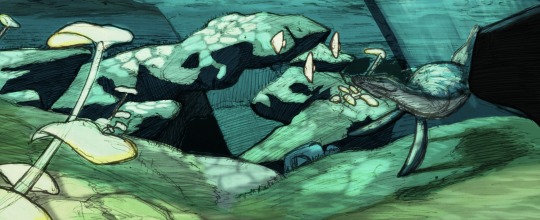
A prehistoric visitor in Treasure Reef.
This was originally drawn when the Season of Abyss first came out.
Uncolored version, cause that one also looks nice:

#Sky cotl#sky children of the light#thatskygame#Season of abyss#Prehistoric marine reptile#Plesiosaur#The colors of Treasure reef were so stunning when it first came out#I knew I had to draw something with it#Sky but with dinosaurs#Not a dinosaur but it’s for the sake of organizing#my art
143 notes
·
View notes
Text
It's prehistoric creature nerd hours so I'm here to talk abt my favorite prehistoric marine reptile:
THE ELASMOSAURUS
This post was originally a google doc I wrote about the Elasmosaurus, all sources can be found at the bottom :]

Who was the Elasmosaurus?
The Elasmosaurus is, as stated before, a marine reptile and not a dinosaur. It is one of the most well known plesiosaurs in the world, and is notable for its extremely long neck. Elasmosaurus lived in the late cretaceous period, and had a diet consisting of small fish and marine invertebrates (piscivore). I find the elasmosaurus to be particularly interesting because of its physical attributes and its complicated discovery.
Elasmosaurus is part of the genus Elasmosauridae. This genus is best known for their remarkably long necks, longer than most plesiosaurs. The elasmosaurus had the second most neck vertebrae of any other creature to ever live on earth, and had a whopping 72 vertebrae. This is only 4 less vertebrae than the Albertonectes (an extinct plesiosaur related to the Elasmosaurus.) Its neck measures in at about 23 feet long (7.1 meters), and its entire body, head to tail, measures in at about 45 feet (14 meters), and weighed 8-10 tons. When the Elasmosaurus was first being studied and reconstructed, it was thought that it could coil its neck like a snake and had lots of flexibility. Some scientists even speculated that in order to hunt, the Elasmosaurus could extend its long neck above the water and look for fish below, but these theories have since been disproven. The neck of the elasmosaurus would have been held quite straight with little movement up and down, but this was actually a key part of its hunting method. The Elasmosaurus most likely would swim up to a school of fish, hiding itself in the darker parts of the water. It used its long neck to grab the fish in its mouth quickly, while not attracting a whole lot of attention. This saved energy because it would not have to swim after fast moving prey. Elasmosaurus was probably not a very fast swimmer, so their way of hunting was essential to their survival. Since it only caught small fish and marine invertebrates, Elasmosaurus would swallow all of its prey whole. Some small stones have been found in remains of Elasmosaurus, and it has been speculated that it would swallow these small stones to help breakdown food. Most paleontologists also believe that the Elasmosaurus gave birth to live young in the water and did not lay eggs.
History
The Elasmosaurus was first discovered in 1868 by Dr. Theophilus Turner (although this is not proven to be true, there are a couple seperate accounts of who originally found the fossils), a military doctor in Kansas, and was sent to paleontologist Edward Drinker Cope for study and identification. Edward Drinker Cope received the specimen in March of 1868, and had no prior knowledge of how to assemble a plesiosaur. He assumed that this marine reptile would likely look similar to the modern day land lizard, with a short neck and long tail, and mistakenly put the head on the end of the tail. In his time, he mostly specialized in lizards, and no one had yet discovered a plesiosaur the size of the elasmosaurus. The history after this point gets a little blurry, but some accounts say that Othniel Charles Marsh, a paleontology professor at Yale University, was the one who pointed out this error. This is said to have been what started what would be known as the “Bone Wars” between the two paleontologists.
Cope announced the discovery of the Elasmosaurus in March 1868, but didn’t tell of his mistake while assembling the Elasmosaurus until August 1869. Marsh would ridicule Cope for this mistake throughout their entire hate-filled feud.
E. D. Cope and the bone wars
E. D. Cope was born on July 28th, 1840 in Philadelphia, Pennsylvania. He was an American paleontologist who was well known for discovering about a thousand different species of extinct vertebrates in the United States. As a young boy, he was described as a “child prodigy” as published his first scientific paper in 1859 at age 19.
The Bone Wars, also named the Great Dinosaur rush, was a rivalry between E. D. Cope and Othniel Charles Marsh. Both paleontologists competed to see who could discover more than the other, and financially drained themselves in their pursuit for paleontological supremacy. Although they ruined themselves and each other financially and both mens reputations were not the best, they both made significant discoveries in the field of paleontology.
------------------------------------------
Although the Elasmosaurus is one of the most well known of the plesiosaurs, not much is known about it. I couldn't find an exact number, but not many Elasmosaurus specimens have been found, making it incredibly hard to study. All of the specimens are incomplete, and although scientists can use prior research to reconstruct the skeleton of this majestic creature, there's still much about Elasmosaurus left to discover. If I'm missing anything or something seems incorrect, plz comment or reblog and let me know!
Sources
https://dino.fandom.com/wiki/Elasmosaurus
http://www.prehistoric-wildlife.com/species/e/elasmosaurus.html
https://plesiosauria.com/directory/genera/elasmosaurus/ (slightly outdated)
https://en.wikipedia.org/wiki/Bone_Wars
https://plesiosauria.com/the-university-of-british-columbias-new-elasmosaurus/
https://ansp.org/exhibits/online-exhibits/stories/bone-wars-the-cope-marsh-rivalry/
E. D. Cope’s original publication
http://oceansofkansas.com/cope1868a.html
41 notes
·
View notes
Text


Mosasaurus. Animal Ghosts. Edited by Claudia Clow. Illustrated by Walt Disney Productions. 1971.
Internet Archive
681 notes
·
View notes
Text
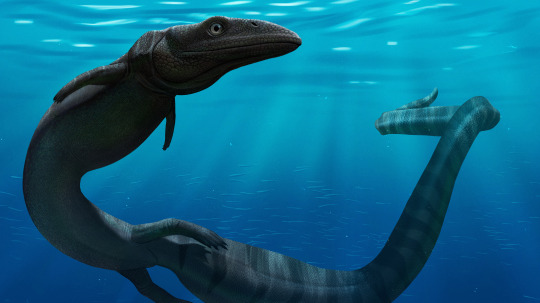
A lone pleurosaurus basks near the water surface before returning to the shallows to hunt small fish.
#my art#pleurosaurus#illustration#paleontology#paleoart#paleoillustration#prehistoric#scales#reptile#wildlife#not#a#dinosaur#marine reptile
745 notes
·
View notes
Note
Potentially dumb question but how do Ichthyosaurs and Pliosaurs fit into everything? Are they more closely related to crocodiles or birds?
And (I'm hesitant to ask this but) are they technically fish in the same way all mammals and thus whales could be argued to be technically fish? (If I've now accidentally made this ask cursed, feel free to delete).
So we don't know where Ichthyosaurs or Plesiosaurs (which includes Pliosaurs) go, exactly, but they aren't more closely related to crocs or birds! They might be close to turtles, or not close to any living reptile group at all. They're an enigma
Mosasaurs, however, are straight up lizards. Like actual giant lizards. We don't know whether they're closer to snakes or monitor lizards, but they're lizards
And yup, aaaaaall of them are fish
172 notes
·
View notes
Text
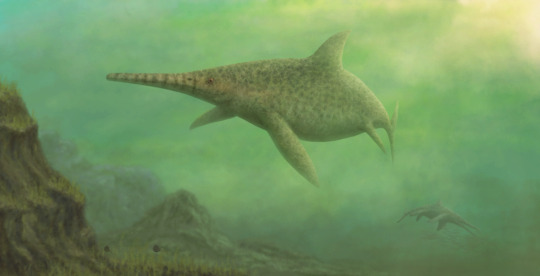
Platypterygius australis
#my art#paleoart#platypterygius#ichtyosaur#mesozoic#cretaceous#marine reptile#nature#digital art#reptile#ocean#aquatic#extinct#prehistoric#animal#paleo#paleontology
62 notes
·
View notes
Photo

Splashy girl bleps until the sun goes down.
250 notes
·
View notes
Text
Yeah I know this poll is a little apex predator heavy, but to be frank, most sea creatures (living and extinct) would amount to nothing more than fish/whale/ichthyosaur/shark, etc. fodder and that would not make for a fun poll.
#poll#wet beast wednesday#fish#crabs#cephalopods#sharks#marine reptiles#sea turtle#jellyfish#box jellyfish#extinct species#prehistoric life#mosasaurus#ichtyosaurs#whales#cetaceans#dolphin#marine life#marine biology
136 notes
·
View notes
Text
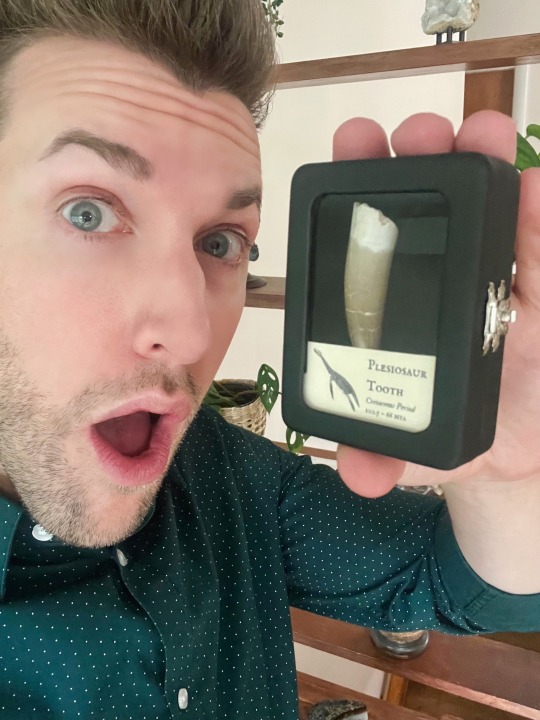
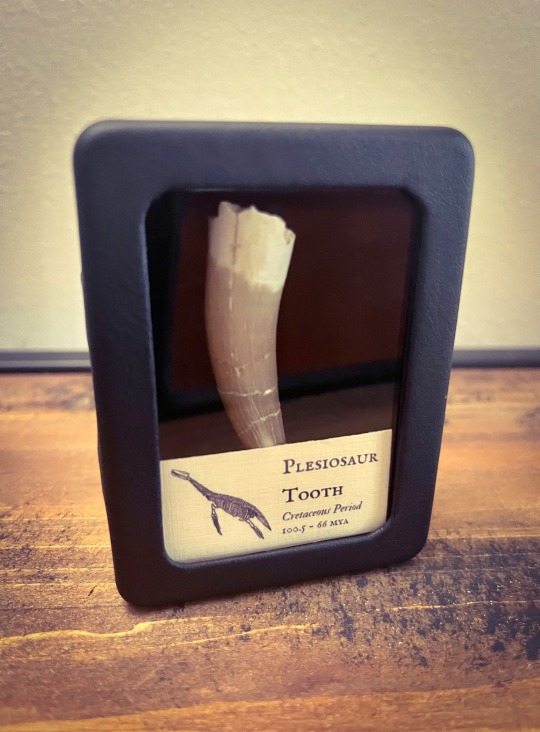
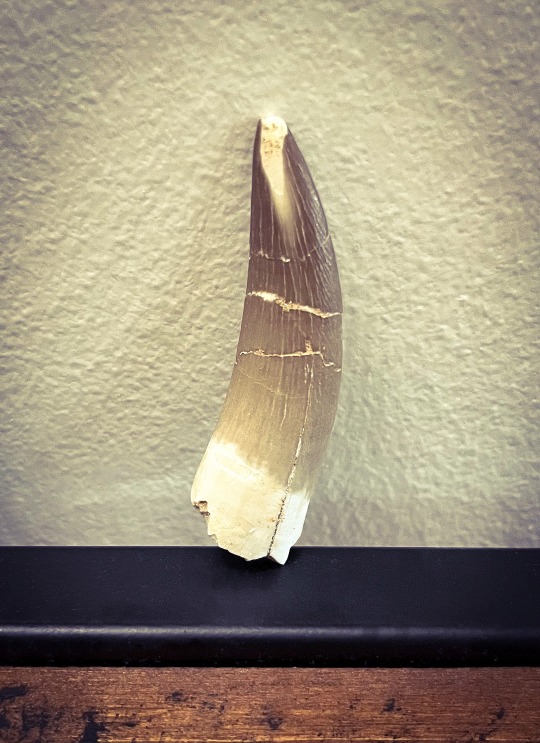
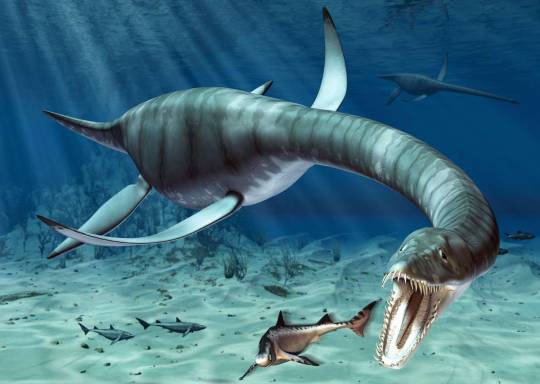


Just added another super cool fossil to the collection! This genuine Plesiosaur tooth was found in Morocco and dates all the way back to the Cretaceous period. It’s also quite a large specimen, measuring almost 2.5” in length!
Plesiosaurs are often mistaken for dinosaurs, however these prehistoric creatures are actually part of a separate group known as "marine reptiles." They first evolved in the Triassic (208.5 MYA) and thrived until the massive KT extinction event caused by the Chicxulub asteroid. This took place at the end of the Cretaceous, and was the same extinction event that wiped out the non-avian dinosaurs (66 MYA). 💥🌊
#collecting#collection#collectibles#collector#dinosaurs#dinosaur#dino#dinos#plesiosaur#loch ness monster#nessie#marine reptile#tooth#fossil#fossils#prehistoric#when dinosaurs ruled the earth#paleontology
89 notes
·
View notes
Text


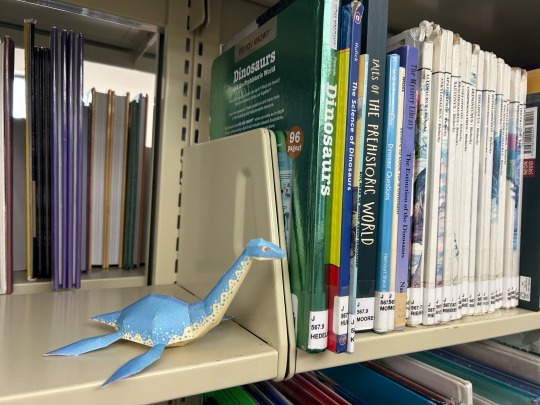
Plesiosaur by the paleontology books
#plesiosaur#paper#papercraft#paper toy#paper model#marine reptile#prehistoric#paleontology#books#science#nonfiction#dinosaurs#cute
138 notes
·
View notes
Text
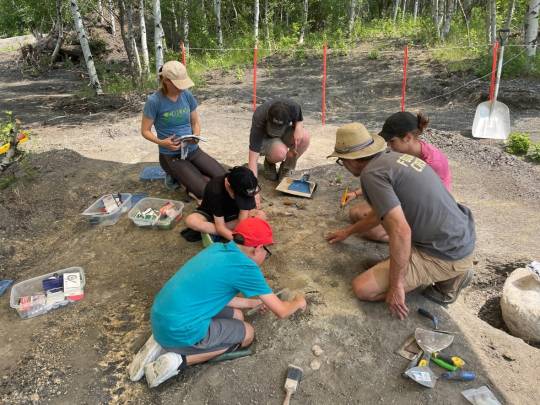
[ Part of the excavation process of the 83-million-year-old mosasaur. ]
"Researchers in southern Manitoba have made the rare discovery of what may be a complete fossilized skeleton belonging to a roughly 83-million-year-old marine reptile.
Excavations are still ongoing, but scientists have uncovered roughly 75 per cent of a mosasaur skeleton near the small community of Miami, Man., about 110 kilometres southwest of Winnipeg.
Finding such an intact skeleton is rare, according to Adolfo Cuetara, the executive director of the Canadian Fossil Discovery Centre in Morden, about 20 kilometres southeast of Miami.
"Normally you're only finding isolated bones, but this time it looks like we have a whole skeleton," he said in an interview with Radio-Canada on Monday.
In early July, a technician with the centre found a small bone while digging with a tractor on a plot of land that used to be a bentonite mine, and which the Morden organization purchased in 2004.
Finding small bones isn't unusual, Cuetara said, but using hand tools, that technician soon realized that the bone was not an isolated discovery.
Over the next several days, the team found 15 vertebrae, all from the same marine reptile, Cuetara said."
Read more: "Marine reptile skeleton dating back to age of dinosaurs discovered in southern Manitoba" from CBC News.
#palaeoblr#Palaeontology#Paleontology#Mosasaur#Marine reptile#Canada#Mesozoic#Cretaceous#Prehistoric#Extinct#Article#Photo#Information
60 notes
·
View notes
Text

Jurassic June day 13.
Tylosaurus.
Commission.
#tylosaurus#mosasaur#jurassicjune#jurassicjune2023#marine reptile#notadinosaur#prehistoricanimals#prehistoric#sea creatures#paleoart#dinoart#dinosaurart#dinosaurartwork
91 notes
·
View notes
Text

"The marked similarity between the shape of the body of the Shark (above), the Ichthyosaur (centre), and Dolphin (below) does not mean that they are all related, but is only the outcome of complete adaptation to the environment, with the same mode of life (convergence)."
Prehistoric Sea Monsters. Written by Dr. Josef Augusta. Illustrated by Zdeněk Burian. 1966.
Internet Archive
#marine life#fish#cartilaginous fish#sharks#prehistoric#prehistoric reptiles#ichthyosaurs#mammals#cetaceans#dolphins#Zdeněk Burian
229 notes
·
View notes
Photo
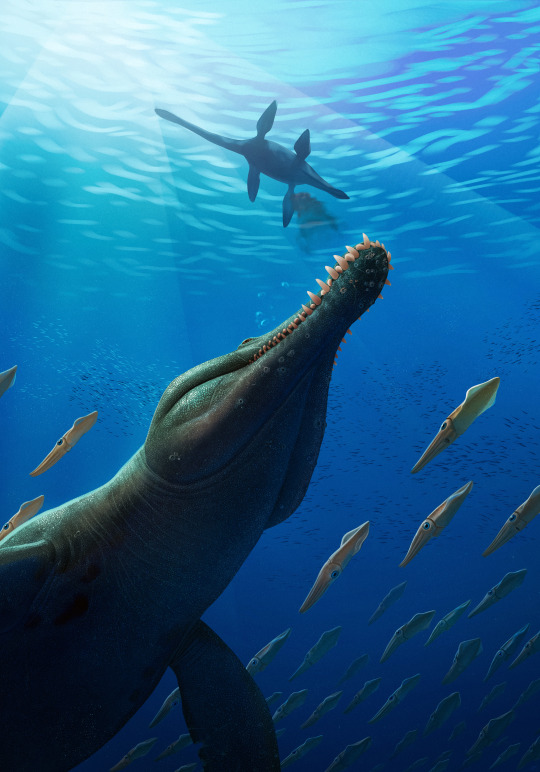
An injured eromangasaurus has attracted the attention of a large kronosaurus lurking below.
#my art#marine reptile#kronosaurus#squid#prehistoric#cretaceous#paleontology#paleoart#paleoillustration#Illustration#ocean#scale#scars#teeth#not#a#dinosaur#marine life#australia
596 notes
·
View notes
Text
I recognize that many would have me add other groups, but I'm specifically doing the "air/land/water" trio that many people think were the only animals alive in the Mesozoic. You know. For fun.
307 notes
·
View notes
Text
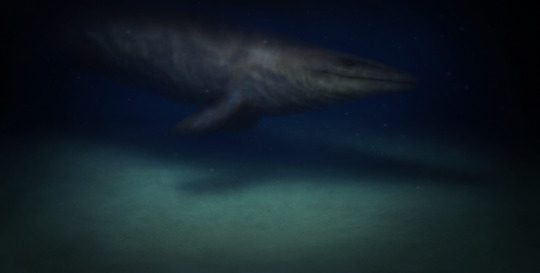
There's something in the water.
#my art#paleoart#sciart#mosasaur#extinct#animal#nature#spooky#reptile#marine animal#cretaceous#carnivore#piscivore#mesozoic#prehistoric
58 notes
·
View notes